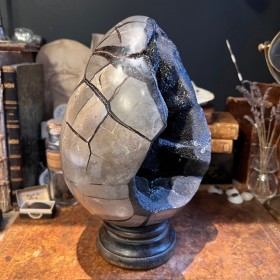
Display for ball or ostrich egg (Large)
High base specially designed to hold a ball or egg
Perfect for ostrich eggs
Not suitable for emu, rhea or swan eggs, for example









Dragon Stone
Septaria egg of Madagascar
It's huge!
Septaria Madagascar egg
Also known as Dragon Stone
Septaria is a stone composed of a mixture of yellow calcite and sandstone, found mainly on the island of Madagascar, characterized by highly visible shrinkage cracks. These highly visible cracks, known as Septa, fill with minerals over time.
When the stone is polished, these cracks stand out, giving it a dragon's egg appearance on the outside.
With time, tectonic movements, etc., the nodules can be fractured and new mineral solutions can invade the shrinkage cracks, often calcite.
In our case, Septaria has been polished into an egg shape and the interior has been invaded by a very fine crystallization of calcite. Beautiful crystals.
It's also easy to see why it's called Dragon's Stone: the exterior is very similar to a dragon's egg!
Sold without base
Ref OSM62: Weight: 7.7kg - Height: 23/24cm It's huge!
Sold without the base
You can find available bases by typing ball base or egg base in the site search
High base specially designed to hold a ball or egg
Perfect for ostrich eggs
Not suitable for emu, rhea or swan eggs, for example
display for ball or egg (small)
Material: Resin material
Wooden base for ball or sphere - Base - support
Grey-Black patinated marble base for ball or sphere
Base - support
Australian saltwater crocodile skull: Crocodylus porosus
Estuary crocodile
With its CITES permit
33cm
Can only be sold in the European Union- Shengen Area
Antique surgical board
From Benjamin Bell's Complete Course in Surgery, published in 1796
Celestine Egg - Mineral WITH base
Origin: Madagascar
Be careful to protect it from water, which alters it: it dissolves or cracks on contact!
Sold with base
Red chalk drawing- Anatomical drawing
Anatomical study
Drawn by Eugène de Montchoisy in Saint-Brieuc in November 1840
These are not reproductions but original period drawings in red chalk.
You are purchasing one plate, not the entire set of plates
Australian saltwater crocodile skull: Crocodylus porosus
Estuary crocodile
With its CITES permit
32cm
Can only be sold in the European Union- Shengen Area
Le corps de l'Homme
Anatomical colour plates with cut-out superimposed leaves
By Edmond Perrier - Schleicher Frères & Cie Editeurs
No date, circa 1900
European lobster - Beauchêne explosion style under glass
Homarus gammarus
By Will Never Die
Available in shop only - No shipping
Anatomie de L'Homme - 1831
Anatomy of Man
Volume 2 with its black and white Atlas - 99 lithography
By Dr Bourgery and the illustrator Jacob
Megalodon tooth fossil - Otodus megalodon
10.2cm
Indonesia
Fossil shark tooth
Deer antler wood sculpture - Octopus on pedestal
Material : Antler
Origin: Indonesia
Anatomical articulated skinning
Paper-cardboard articulated mannequin
Human skeleton
Entomological composition of beetles
28 specimens make up this picture
Black entomological box: 26x39cm
Human skull - Replica by artist Jérôme Cavailles
Ref: Août 19
Engraved horse skull
Papuan handicraft
Origin: West Papua
Butterfly - Natural History color plate
Entomology
You buy 1 plate, not the whole set

Dragon Stone
Septaria egg of Madagascar
It's huge!









